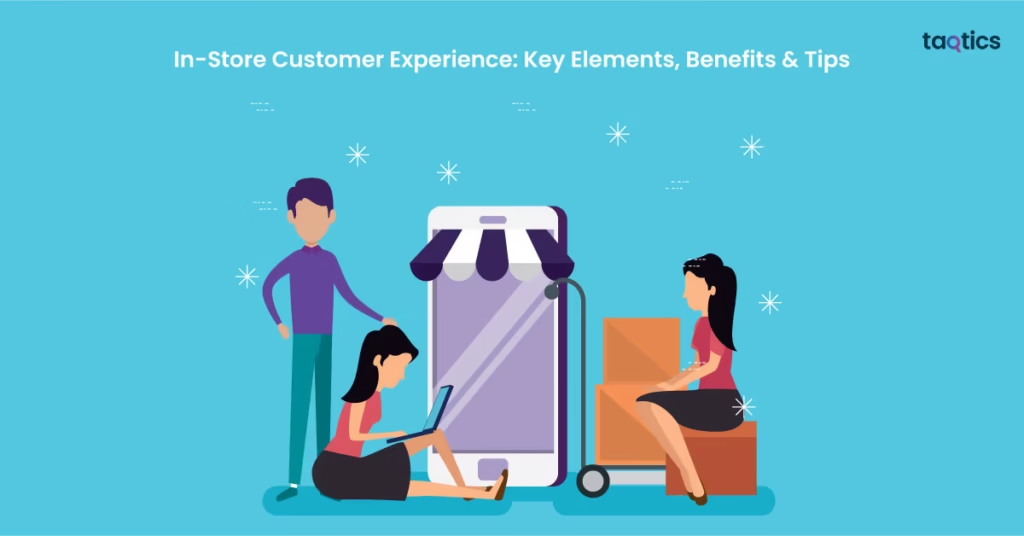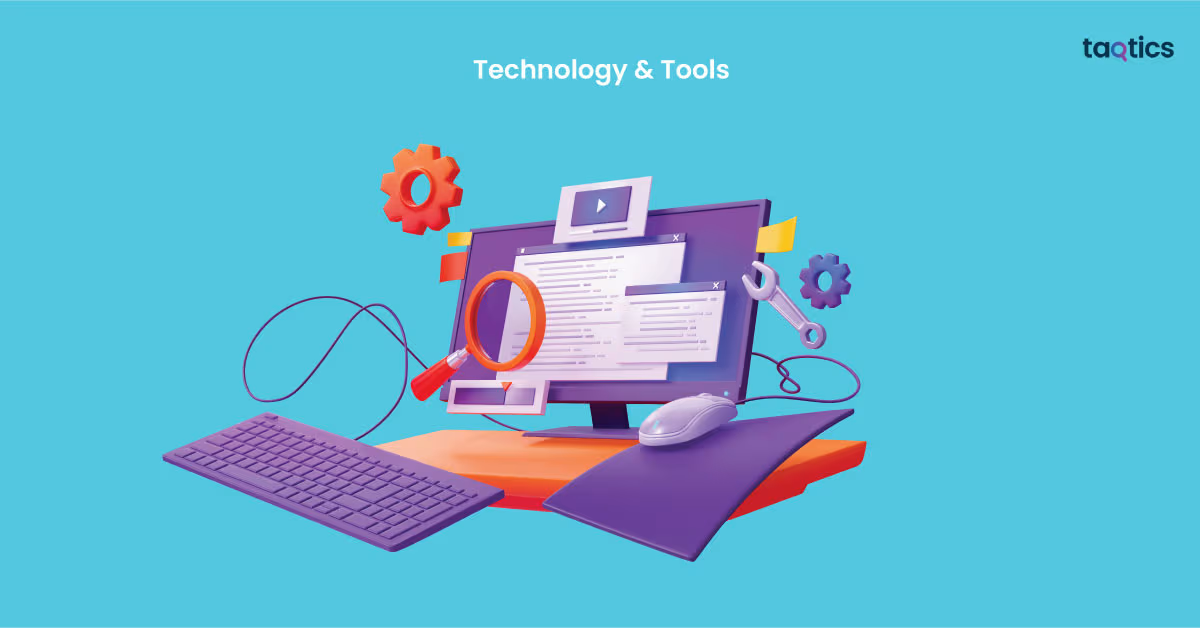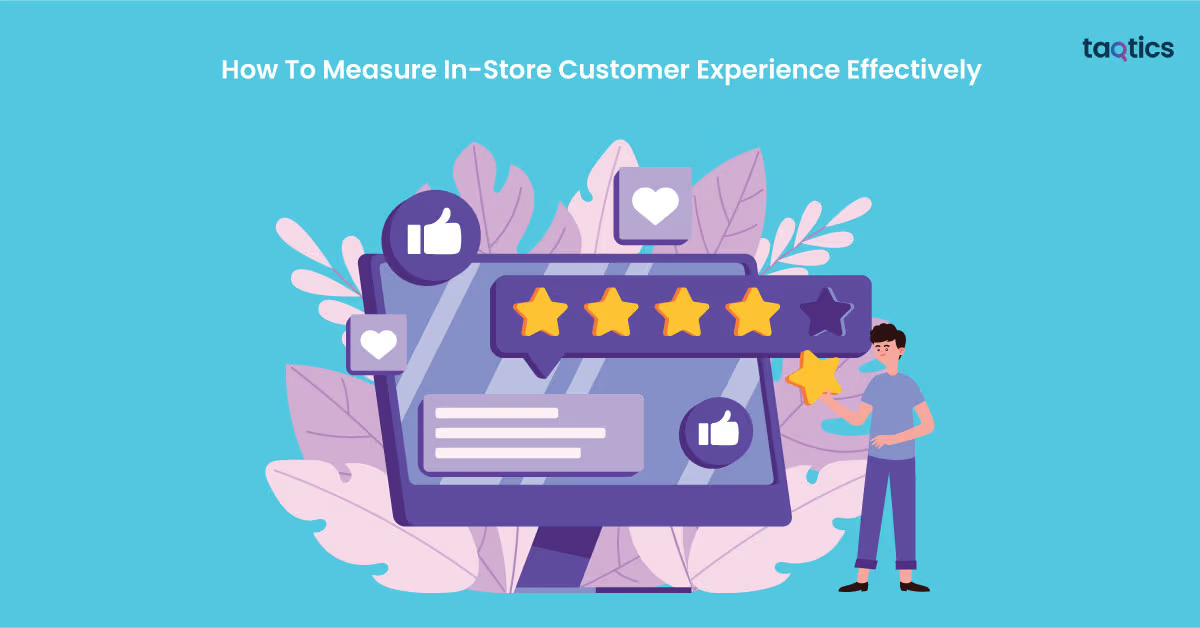In-Store Customer Experience: Key Elements, Benefits & Tips

In-store customer experience is the heartbeat of brick-and-mortar retail success. In-store customer experience influences how customers feel, behave, and remember your brand long after they leave your store. From the layout of the aisles to the friendliness of staff and the ease of checkout, every detail contributes to how a shopper perceives their visit. In today’s retail landscape, where e-commerce offers convenience at a click, physical stores must offer something more, something memorable.
Research by PwC shows that 73% of consumers point to experience as an important factor in their purchasing decisions, yet only 49% say companies provide a good customer experience. Moreover, a report by Salesforce reveals that 80% of customers say the experience a company provides is as important as its products and services. These stats make one thing clear: experience isn’t a luxury—it’s a differentiator.
Retailers who prioritize in-store experience see measurable returns, from increased foot traffic and longer dwell times to higher average transaction values and stronger customer loyalty. Whether you’re a boutique store or a large retail chain, improving the customer experience can set you apart in a competitive market. In this article, we’ll break down the core elements that define exceptional in-store experiences, explore the benefits they deliver, and share practical tips to help you elevate every touchpoint inside your store.
What Is In‑Store Customer Experience?
In-store customer experience is the sum of every interaction a customer has within a physical retail environment, from the moment they enter to the moment they leave. In-store customer experience includes factors like store layout, employee behavior, ambiance, product displays, and even how easy it is to find help or check out.
It’s about how customers feel while shopping. According to a McKinsey report, 70% of buying experiences are based on how the customer feels they are being treated. A well-designed in-store experience can increase customer satisfaction, encourage repeat visits, and drive sales. In fact, research by Mood Media found that 78% of consumers say an enjoyable in-store atmosphere, through music, visuals, and scent, makes them more likely to stay longer and shop more.
Ultimately, in-store customer experience plays a critical role in brand perception and business success. It’s what turns casual shoppers into loyal customers and physical spaces into brand destinations.
What Is The Importance of In‑Store Customer Experience?
The importance of in-store customer experience lies in its powerful influence on sales, brand loyalty, and competitive differentiation. A well-crafted in-store experience not only attracts customers but also drives purchasing decisions and increases the likelihood of repeat visits. According to a report by Forrester, improving customer experience can increase customer retention rates by 92%, significantly boosting lifetime value.
Positive in-store experiences build emotional connections, which are critical for brand loyalty. In fact, 65% of consumers say a positive experience with a brand is more influential than great advertising. Shoppers who feel valued and engaged are more likely to recommend the brand to others and return, turning into brand advocates over time.
Additionally, in a highly competitive retail environment, experience is often what sets one store apart from another. While products and prices can be matched, the experience a store offers is unique. Research by Deloitte shows that customer experience-driven businesses are 60% more profitable than those that don’t prioritize it. In essence, the in-store customer experience isn’t just a service layer, but a strategic business advantage.
What Are the Key Components of a Great In‑Store Experience?
The key components of a great in-store experience go beyond just product availability—they focus on creating an environment that is engaging, intuitive, and emotionally satisfying for the customer.
Store Environment & Visual Merchandising
The store environment plays a powerful psychological role in shaping customer perceptions and behavior. Elements like lighting, music, scent, cleanliness, and color psychology work together to create an emotional atmosphere that can either invite shoppers to explore or drive them away. Research by Mood Media found that 84% of shoppers say music positively influences their mood in-store, while 65% say a pleasant scent enhances their shopping experience.
Cleanliness is equally critical, with 99% of consumers in a Retail TouchPoints survey stating that a dirty store negatively impacts their impression of a brand. Color psychology also matters. For example, warm tones like red and orange create urgency, while cooler tones like blue evoke trust and calmness, directly influencing browsing time and purchase decisions.
Visual merchandising strategies such as planograms and store layouts, whether grid, loop, or free-flow, guide customer movement and product discovery. Grid layouts are efficient for high-inventory stores like supermarkets, while loop layouts encourage a circular flow and maximize product exposure. Free-flow layouts are ideal for boutiques, offering a relaxed and personalized feel. Additionally, attention-grabbing displays like seasonal setups, end caps, and window dressings play a key role in storytelling and promotions.
According to the POPAI, 82% of purchase decisions are made in-store, highlighting the importance of strategic visual presentation. Effective signage and focal points not only inform but also subtly influence buyer behavior, making visual merchandising an essential component of a successful in-store experience.
Staff & Service
Staff interactions are one of the most influential aspects of the in-store customer experience. A warm greeting, genuine eye contact, and a helpful attitude can make customers feel seen, valued, and more likely to make a purchase. According to a study by the Temkin Group, 77% of consumers say a positive interaction with store staff is a key factor in their loyalty to a brand. Simple behaviors, like acknowledging customers within the first 30 seconds, can significantly improve satisfaction and reduce walkouts.
Friendly, proactive service doesn’t just enhance the experience; it humanizes the brand and builds an emotional connection. To deliver consistent, high-quality service, retailers must invest in staff training, empowerment, and engagement. Well-trained employees who are empowered to solve problems create smoother, more enjoyable shopping journeys. Engaged staff are also more likely to go above and beyond. Gallup reports that highly engaged teams show 21% greater profitability.
Personalized service is another layer of excellence; tools like clienteling and CRM integration allow staff to offer tailored recommendations based on purchase history or preferences. This kind of one-on-one attention not only drives sales but also builds long-term loyalty, with Salesforce finding that 70% of consumers say connected processes, like personalized communication, are very important to winning their business.
Technology & Tools
Technology plays a pivotal role in elevating the in-store customer experience by adding convenience, personalization, and interactivity. Features like free in-store Wi-Fi, digital signage, mobile checkout, and augmented reality (AR) mirrors not only streamline the shopping process but also enhance engagement. For example, AR mirrors allow customers to virtually try on clothing or makeup, reducing friction and increasing confidence in purchase decisions.

According to a study by PwC, 59% of consumers say they are more likely to shop at stores that offer digital experiences like smart fitting rooms or self-checkout. Mobile point-of-sale (POS) systems, meanwhile, speed up transactions and reduce queue times, which is crucial since 86% of consumers say they will leave a store if the wait is too long.
Beyond convenience, technology also helps retailers gather and act on customer insights. Tools like feedback kiosks and real-time sentiment analysis allow brands to respond to shopper concerns and continuously improve service quickly. Additionally, seamless integration with online channels, such as Buy Online, Pick Up In Store (BOPIS), digital inventory visibility, and app-based loyalty programs, creates a unified, omnichannel experience. Research from Salesforce reveals that 75% of shoppers expect consistent experiences across physical and digital touchpoints. When in-store technology is thoughtfully implemented, it not only improves operational efficiency but also meets modern consumer expectations for speed, personalization, and flexibility.
Layout & Navigation
Store layout and navigation play a critical role in guiding customer behavior and maximizing both comfort and sales. Effective design begins with ease of movement. Aisles should be wide enough to allow free flow, and product groupings should follow intuitive logic. Key zones such as the decompression zone (the area just inside the entrance), transition areas, and power walls (the first walls customers see when they enter) are strategically important.
Research from Retail Doctor Group shows that shoppers make up to 70% of their purchase decisions in-store, meaning the path they follow and what they encounter along the way directly influence sales. Thoughtfully designed layouts, whether grid, loop, or free-flow, encourage exploration while subtly steering customers toward high-margin or promotional items.
Equally important are accessibility and signage clarity. Clear directional signs, visible pricing, and well-labeled sections reduce friction and cognitive overload, making shopping more enjoyable and efficient. Accessibility considerations, such as ramps, uncluttered walkways, and low shelving, ensure all customers, including those with disabilities, can shop comfortably. Shopper psychology also plays a role: for instance, most people naturally turn right when entering a store, making that first impression zone ideal for high-impact displays.
According to a study by Retail Dive, 62% of consumers are more likely to return to a store that is easy to navigate. In short, a smart layout doesn’t just improve flow, it enhances experience, supports inclusivity, and drives better business outcomes.
Checkout & Queues
The checkout process is the final impression a store leaves on its customers, and it can make or break the overall in-store experience. Speed and efficiency at the point of sale (POS) are critical, as long wait times are a top cause of cart abandonment. According to a study by Oracle, 60% of consumers say they would stop shopping at a store if the checkout is consistently slow. Offering self-checkout stations, mobile payment options, and well-managed queues helps minimize delays and gives shoppers more control. Smart queue management tools, such as digital wait time displays or mobile alerts, reduce perceived wait times and improve customer satisfaction.
Beyond speed, checkout areas are also powerful zones for driving last-minute purchases. Well-placed impulse items, like snacks, travel-sized products, or seasonal accessories, can significantly boost average transaction value. At the forefront of innovation are frictionless checkout models like Apple’s mobile payment system and Amazon Go’s Just Walk Out technology, which uses sensors and AI to charge customers as they leave automatically. These seamless experiences reduce hassle and align with modern expectations for convenience and autonomy. As consumers increasingly prioritize speed and personalization, a frictionless, well-designed checkout is no longer optional; it’s essential to a great in-store experience.
Returns, Exchanges & Service Recovery
An easy, transparent return and exchange process is a cornerstone of a positive in-store customer experience. A hassle-free return policy not only builds trust but also removes the fear of making a wrong purchase. According to a UPS Pulse of the Online Shopper study, 68% of shoppers say return policies directly influence their decision to buy. In brick-and-mortar settings, a smooth return experience can turn a potentially negative moment into an opportunity to strengthen brand loyalty. Clear signage about return terms, visible return counters, and speedy processing all contribute to a stress-free experience that leaves customers feeling respected and valued.
Equally important is how staff handle service recovery. Employees must be trained to respond to dissatisfaction with empathy, patience, and solutions. A well-handled complaint or return can actually increase a customer’s likelihood of returning; in fact, the service recovery paradox shows that customers who experience a problem that’s quickly resolved are more loyal than those who never had an issue. Implementing feedback loops, such as follow-up emails post-return or real-time exit surveys, helps retailers identify recurring pain points and improve future experiences. When service recovery is proactive and human-centered, it doesn’t just fix a problem, but reinforces trust and keeps customers coming back.
From the moment a shopper steps inside, every element of the store should work together to create a seamless and memorable journey. Together, these elements not only encourage purchases but also build stronger customer loyalty and set your brand apart in a crowded market.
How To Measure In‑Store Customer Experience Effectively?
To measure in-store customer experience effectively, retailers need to combine quantitative data with qualitative insights to capture both what customers do and how they feel. Metrics like Net Promoter Score (NPS), Customer Satisfaction (CSAT), and Customer Effort Score (CES) offer valuable snapshots of shopper sentiment. For instance, research by Bain & Company shows that companies with high NPS grow more than twice as fast as their competitors. Regularly collecting this feedback through kiosks, tablets, or post-visit surveys helps identify areas of strength and improvement directly from the customer’s perspective.

In addition to feedback scores, analyzing behavioral data such as dwell time, foot traffic, conversion rates, and return visits provides insight into how engaging and efficient the in-store environment is. According to RetailNext, stores that optimize layout and engagement zones can see sales conversions rise by up to 20%. Integrating in-store analytics with CRM tools allows businesses to track individual journeys and personalize experiences over time. Combining hard data with human feedback enables retailers to make informed, customer-driven decisions that continuously enhance the in-store experience.
What Are the Best Practices of In‑Store CX?
The best practices of in-store CX focus on blending convenience, personalization, and emotional connection to create memorable, customer-centric environments. Retailers should design intuitive store layouts, provide fast and friendly service, maintain a welcoming atmosphere through music and lighting, and offer personalized interactions powered by CRM tools. Investing in staff training, technology integration, and a seamless omnichannel journey is essential. According to a Salesforce report, 88% of customers say the experience a company provides is as important as its products or services, underscoring the strategic value of a strong in-store experience.
Leading retailers are already setting high benchmarks. Macy’s, for example, has reimagined its stores by incorporating experiential areas like interactive beauty counters, curated Instagram-worthy displays, and even pop-up shops, inviting shoppers to linger and engage with the brand beyond transactions. Liberty London streamlines service using Zendesk, enabling store staff to access customer profiles, past purchases, and preferences in real time. This empowers associates to offer highly personalized and efficient service, reducing friction and increasing loyalty. By learning from such examples, brands can apply best practices that not only meet but exceed modern customer expectations.



